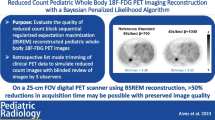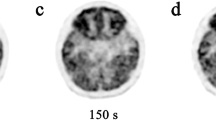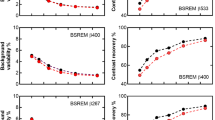Abstract
Background
18F-2-fluoro-2-deoxyglucose (FDG) positron emission tomography (PET) plays an important role in the diagnosis, evaluation and treatment of childhood epilepsy. The selection of appropriate acquisition and reconstruction parameters, however, can be challenging with the introduction of advanced hardware and software functionalities.
Objective
To quantify the diagnostic performance of a block-sequential regularized expectation maximization (BSREM) tool and reduced effective counts in brain PET/CT for pediatric epilepsy patients on a digital silicon photomultiplier system.
Materials and methods
We included 400 sets of brain PET/CT images from 25 pediatric patients (0.5–16 years old) in this retrospective study. Patient images were reconstructed with conventional iterative techniques or BSREM with varied penalization factor (β), at varied acquisition time (45 s, 90 s, 180 s, 300 s) to simulate reduced count density. Two pediatric nuclear medicine physicians reviewed images in random order — blinded to patient, reconstruction method and imaging time — and scored technical quality (noise, spatial resolution, artifacts), clinical quality (image quality of the cortex, basal ganglia and thalamus) and overall diagnostic satisfaction on a 5-point scale.
Results
Reconstruction with BSREM improved quality and clinical scores across all count levels, with the greatest benefits in low-count conditions. Image quality scores were greatest at 300-s acquisition times with β=500 (overall; noise; artifacts; image quality of the cortex, basal ganglia and thalamus) or β=200 (spatial resolution). No statistically significant difference in the highest graded reconstruction was observed between imaging at 180 s and 300 s with an appropriately implemented penalization factor (β=350–500), indicating that a reduction in dose or acquisition time is feasible without reduction in diagnostic satisfaction.
Conclusion
Clinical evaluation of pediatric 18F-FDG brain PET image quality was shown to be diagnostic at reductions of count density by 40% using BSREM with a penalization factor of β=350–500. This can be accomplished while maintaining confidence of achieving a diagnostic-quality image.






Similar content being viewed by others
References
Aaberg KM, Gunnes N, Bakken IJ et al (2017) Incidence and prevalence of childhood epilepsy: a nationwide cohort study. Pediatrics 139:e20163908
Fitsiori A, Hiremath S, Boto J et al (2019) Morphological and advanced imaging of epilepsy: beyond the basics. Children 6:43
Berg AT, Shinnar S, Levy SR et al (2001) Early development of intractable epilepsy in children: a prospective study. Neurology 56:1445–1452
Ollenberger GP, Byrne AJ, Berlangieri SU et al (2005) Assessment of the role of FDG PET in the diagnosis and management of children with refractory epilepsy. Eur J Nucl Med Mol Imaging 32:1311–1316
Chugani HT, Conti JR (1996) Etiologic classification of infantile spasms in 140 cases: role of positron emission tomography. J Child Neurol 11:44–48
Burneo JG, Poon R, Kellett S, Snead OC (2015) The utility of positron emission tomography in epilepsy. Can J Neurol Sci 42:360–371
la Fougère C, Rominger A, Förster S et al (2009) PET and SPECT in epilepsy: a critical review. Epilepsy Behav 15:50–55
Sarikaya I (2015) PET studies in epilepsy. Am J Nucl Med Mol Imaging 5:416–430
Hsu DFC, Ilan E, Peterson WT et al (2017) Studies of a next-generation silicon-photomultiplier-based time-of-flight PET/CT system. J Nucl Med 58:1511–1518
Teoh EJ, McGowan DR, Macpherson RE et al (2015) Phantom and clinical evaluation of the Bayesian penalized likelihood reconstruction algorithm Q.Clear on an LYSO PET/CT system. J Nucl Med 56:1447–1452
Lantos J, Mittra ES, Levin CS, Iagaru A (2018) Standard OSEM vs. regularized PET image reconstruction: qualitative and quantitative comparison using phantom data and various clinical radiopharmaceuticals. Am J Nucl Med Mol Imaging 8:110–118
Lantos J, Iagaru A, Levin CS (2016) Scanner dependent noise properties of the Q. Clear PET image reconstruction tool. 2015 IEEE Nucl Sci Symp Med Imaging Conf NSS/MIC 2015:1–3
Gelfand MJ, Parisi MT, Treves ST (2011) Pediatric radiopharmaceutical administered doses: 2010 North American consensus guidelines. J Nucl Med 52:318–322
Viera AJ, Garrett JM (2005) Understanding interobserver agreement: the kappa statistic. Fam Med 37:360–363
Lindström E, Sundin A, Trampal C et al (2018) Evaluation of penalized-likelihood estimation reconstruction on a digital time-of-flight PET/CT scanner for 18 F-FDG whole-body examinations. J Nucl Med 59:1152–1158
Messerli M, Stolzmann P, Egger-Sigg M et al (2018) Impact of a Bayesian penalized likelihood reconstruction algorithm on image quality in novel digital PET/CT: clinical implications for the assessment of lung tumors. EJNMMI Phys 5:27
Sekine T, Delso G, Zeimpekis KG et al (2018) Reduction of 18F-FDG dose in clinical PET/MR imaging by using silicon photomultiplier detectors. Radiology 286:249–259
Trägårdh E, Minarik D, Almquist H et al (2019) Impact of acquisition time and penalizing factor in a block-sequential regularized expectation maximization reconstruction algorithm on a Si-photomultiplier-based PET-CT system for 18F-FDG. EJNMMI Res 9:64
Otani T, Hosono M, Kanagaki M et al (2019) Evaluation and optimization of a new PET reconstruction algorithm, Bayesian penalized likelihood reconstruction, for lung cancer assessment according to lesion size. AJR Am J Roentgenol 213:W50–W56
Reynés-Llompart G, Gámez-Cenzano C, Vercher-Conejero JL et al (2018) Phantom, clinical, and texture indices evaluation and optimization of a penalized-likelihood image reconstruction method (Q.Clear) on a BGO PET/CT scanner. Med Phys 45:3214–3222
Acknowledgments
We acknowledge Susan McQuattie and Nancy Ribeiro for their contributions to this work.
Author information
Authors and Affiliations
Corresponding author
Ethics declarations
Conflicts of interest
None
Additional information
Publisher’s note
Springer Nature remains neutral with regard to jurisdictional claims in published maps and institutional affiliations.
Rights and permissions
About this article
Cite this article
Shkumat, N.A., Vali, R. & Shammas, A. Clinical evaluation of reconstruction and acquisition time for pediatric 18F-FDG brain PET using digital PET/CT. Pediatr Radiol 50, 966–972 (2020). https://doi.org/10.1007/s00247-020-04640-1
Received:
Revised:
Accepted:
Published:
Issue Date:
DOI: https://doi.org/10.1007/s00247-020-04640-1




